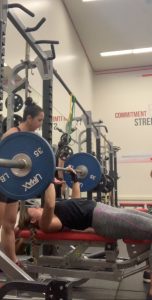Introducing your strength-training clients to negative lifting, aka, employing negatives, might be a progressive overload approach worth considering, especially if you’re helping them to push through a slump or speed up results.
Creative Approaches to Progressive Overloading
Last month I discussed the importance of trainers holding some creative progressive overload techniques in their back pockets when clients hit strength gain plateaus. Specifically, I discussed tempo or Time Under Tension (TUT) as one such approach.
While plateaus may be inevitable, clients may feel discouraged and/or unmotivated to reach their goals. This is where you as the trainer need to reach into your creative pocket and pull out an approach to keep them coming back. Negative lifting may be the bang for the buck they’re looking for.
What is Negative Lifting?
Negatives are a slow 3-5 second tempo, heavy eccentric (lengthening phase) movement that is best performed with a partner, spotter, or trainer. Negatives capitalize on the eccentric motion of an exercise by exploiting the nature of opposing forces: when the opposing force is greater than the muscles’ force production, the muscle must fight to control that weight as it lengthens, and hence, the eccentric phase is enhanced. Eccentric phases are able to produce greater force output than concentric phases and therefore, can move more weight.
When is Negative Lifting Appropriate?
First, negatives are appropriate with eccentric exercises. Examples include: the lowering phase of a shoulder press or lying bench press, or even the downward motion of a squat (a trickier movement to execute as a negative—it would most likely require two spotters).
Second, negatives are more effectively employed once 1 rep max (1RM) testing has been completed, because:
- When 1RM is acutely increased on the eccentric phase of the lift, it creates a 5-15lb concentric phase strength increase! This relationship is a result of enhanced neural stimulation, greater muscle spindle stretch, and increased motor nerve, which is ideal for plateau breakthroughs.
- Negative lifting requires applying a percentage of supera-maximal 1RM. To be exact 105%-125% of 1RM
In other words, in order to accurately and safely calculate the heavier weight required for a negative set, you need to know the maximal weight you can handle for the entire movement: the 1RM for that exercise.
Third, negatives are appropriate for those who are working out with someone who can help return the weight to the starting position.
How to Program Negative Lifting?
Adding negatives into your clients’ training periodization starts with considering their training volume. 3-4 times per week is a realistic number to shoot for.
Negatives should be incorporated towards the end of a session, once all of the main work is complete. Think of accessory work.
When employing a negative approach, a 3-5 second tempo should be used for 2-3 sets of 3-4 reps.
 Example: Bench press
Example: Bench press
Select the appropriate weight: If your client’s 1RM is 150 pounds for a bench press, start with 160.
Help him or her unrack the weight and spot the bar as it is lowered towards the chest.
You will now assist on the concentric phase as much as possible as your client returns the bar to start.
Remember to let go of the bar on the way back down but continue to spot!
Why Incorporate Negative Lifting?
Negatives are dubbed a powerful technique eliciting a rapid strength growth/response because:
- Muscles are stronger in the eccentric phase
- They progressively overload the muscle in a different way
- Eccentric training can acutely increase resting metabolism
What are some other ideal exercises that you can incorporate negatives?
References
/www.ideafit.com/fitness-library/eccentric-exercise
https://www.ideafit.com/fitness-library/five-benefits-of-eccentric-exercise
www.ideafit.com/fitness-library/muscle-hypertrophy


